Students must practice these Maths 2A Important Questions TS Inter Second Year Maths 2A De Moivre’s Theorem Important Questions Very Short Answer Type to help strengthen their preparations for exams.
TS Inter Second Year Maths 2A De Moivre’s Theorem Important Questions Very Short Answer Type
Question 1.
Simplify \(\frac{(\cos \alpha+i \sin \alpha)^4}{(\sin \beta+i \cos \beta)^8}\)
Solution:
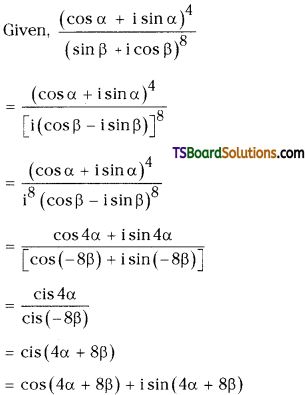
Question 2.
Find the value of (1 – i)8. [March ’07]
Solution:

Let 1 – i = r (cos θ + i sin θ)
then r cos θ = 1, r sin θ = – 1
Hence,
√2 cos θ = 1, √2 sin θ = – 1
cos θ = \(\frac{1}{\sqrt{2}}\), sin θ = – \(\frac{1}{\sqrt{2}}\)
∴ θ lies in the Q4
∴ θ = – \(\frac{\pi}{4}\)
1 – i = √2 [cos (- \(\frac{\pi}{4}\)) + i sin (\(\frac{\pi}{4}\))]
= √2 (cos \(\frac{\pi}{4}\) – i sin \(\frac{\pi}{4}\))
Now,
(1 – i)8 = [√2 (cos (\(\frac{\pi}{4}\)) – i sin (\(\frac{\pi}{4}\)))]8
= 16 (cos 2π – i sin 2π)
= 16 (1 – i . 0) = 16.

Question 3.
Find the value of (1 + i)16. [Board Paper]
Solution:
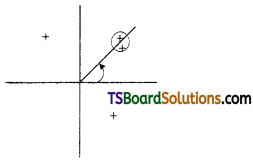
Let (1 – i) = r (cos θ + i sin θ)
then r cos θ = 1, r sin θ = 1
r = \(\sqrt{\mathrm{x}^2+\mathrm{y}^2}=\sqrt{1^2+1^2}=\sqrt{1+1}=\sqrt{2}\)
Hence,
√2 cos θ = 1, √2 sin θ = 1
cos θ = \(\frac{1}{\sqrt{2}}\), sin θ = \(\frac{1}{\sqrt{2}}\)
∴ θ lies in the Q1.
∴ θ = \(\frac{\pi}{4}\)
∴ 1 + i = √2 (cos \(\frac{\pi}{4}\) + i sin \(\frac{\pi}{4}\))
Now,
(1 + i)16 = [√2 (cos(\(\frac{\pi}{4}\)) + i sin (\(\frac{\pi}{4}\))]16
= (√2)16 (cos 4π + i sin 4π)
= 256 (1 + i (0)) = 256
Question 4.
Find the value of \(\left(\frac{\sqrt{3}}{2}+\frac{i}{2}\right)^5-\left(\frac{\sqrt{3}}{2}-\frac{i}{2}\right)^5\). [May 2004]
Solution:

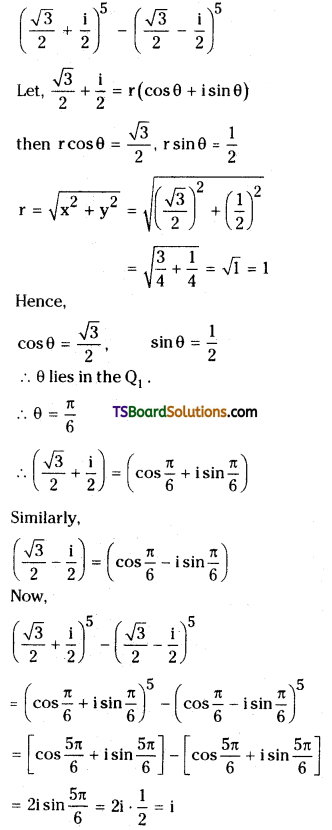

Question 5.
If A, B, C are angles of a triangle such that x = cis A, y = cis B, z = cis C, then find the value of xyz.
[Mar. ’98, ’94 AP – Mar. ’18, ’16, ’15, May ’16; TS – May ’15]
Solution:
Since, A, B, C are angles of a triangle then A+ B + C = π
Given that,
x = cis A, y= cis B, z = cis C
Now, xyz = cis A . cis B . cis C
= cis (A + B + C)
= cos (A + B + C) + i sin (A + B + C)
= cos π + i sin π
= – 1 + i (0) = – 1.
Question 6.
If x = cis θ then find the value of \(\left(x^6+\frac{1}{x^6}\right)\).
[TS – Mar. 2018, May 2016, May ’14, ’07, March ’14, ’04, ’91]
Solution:
Given, x = cis θ
= cos θ + i sin θ
Now, x6 = (cos θ + i sin θ)6
= cos 6θ + i sin 6θ
\(\frac{1}{x^6}\) = cos 6θ – i sin 6θ
Now,
x6 + \(\frac{1}{x^6}\) = cos 6θ + i sin 6θ + cos 6θ – i sin 6θ = 2 cos 6θ.
Question 7.
Find the cube roots of 8.
Solution:
Let, x = \(\sqrt[3]{8}=(8)^{1 / 3}=8^{1 / 3} 1^{1 / 3}\)
= \(\left(2^3\right)^{1 / 3}\) [cos 0° + i sin 0°]1/3
= 2[cos(2kπ + 0°) + isin(2kπ + 0°)]1/3
k = 0, 1, 2
= 2[cos 2kπ + isin2kπ]1/3
= 2 \(\left[\cos \frac{2 \mathrm{k} \pi}{3}+\mathrm{i} \sin \frac{2 \mathrm{k} \pi}{3}\right]\)
= 2 cis \(\frac{2 \mathrm{k} \pi}{3}\), k = 0, 1, 2
If k = 0
⇒ x = 2 cis 0° = 2 (cos 0 + i sin 0)
= 2 (1 + i . 0) = 2
If k = 1
⇒ x = 2 cis \(\frac{2 \pi}{3}\)
= 2 (cos \(\frac{2 \pi}{3}\) + i sin \(\frac{2 \pi}{3}\))
= \(2\left[\frac{-1}{2}+\frac{\mathrm{i} \sqrt{3}}{2}\right]=2\left[\frac{-1+\mathrm{i} \sqrt{3}}{2}\right]\) = 2ω
If k = 2
⇒ x = 2 cis \(\frac{4 \pi}{3}\)
= 2 (cos \(\frac{4 \pi}{3}\) + i sin \(\frac{4 \pi}{3}\))
= \(2\left(\frac{-1}{2}-\mathrm{i} \frac{\sqrt{3}}{2}\right)=2\left[\frac{-1-\mathrm{i} \sqrt{3}}{2}\right]\)
= 2ω2
∴ The cube roots of 8 are 2, 2ω, 2ω2.

Question 8.
Prove that – ω and – ω2 are roots of z2 – z + i = 0, where ω and ω2 are the complex cube roots of unity.
Solution:
Since ω, ω2 are the cube roots of unity then
ω = \(\frac{-1+i \sqrt{3}}{2}\)
⇒ – ω = \(\frac{1-i \sqrt{3}}{2}\)
ω2 = \(\frac{-1-i \sqrt{3}}{2}\)
⇒ – ω2 = \(\frac{1+i \sqrt{3}}{2}\)
Given quadratic equation is z2 – z + 1 = 0
Comparing with ax2 + bx + c = 0
a = 1, b = – 1, c = 1
∴ The roots of the quadratic equation z2 – z + 1 = 0 then
z = \(\frac{-\mathrm{b} \pm \sqrt{\mathrm{b}^2-4 \mathrm{ac}}}{2 \mathrm{a}}\)
= \(\frac{-(-1) \pm \sqrt{(-1)^2-4 \cdot 1 \cdot 1}}{2(1)}\)
= \(\frac{1 \pm \sqrt{1-4}}{2}=\frac{1 \pm i \sqrt{3}}{2}\)
∴ – ω and – ω2 are the roots of z2 – z + 1 = 0.
Question 9.
If 1, ω, ω2 are the cube roots of unity, prove that [TS – Mar. 2016]
(1 – ω + ω2)6 + (1 – ω2 + ω)6 = 128 = (1 – ω + ω2)7 + (1 + ω – ω2)7
Solution:
Given that 1, ω, ω2 are the cube roots of unity then
1 + ω + ω2 = 0 and ω3 = 1
(1 – ω + ω2)6 + (1 – ω2 + ω)6 = (- ω – ω)6 + (- ω2 – ω2)6
= (2ω)6 + (- 2ω2)6
= (- 2)6 ω6 + (- 2)6 ω6
= 64 . 1 + 64 . 1
= 64 + 64 = 128
∴ (1 – ω + ω2) + (1 – ω2 + ω) = 128
and (1 – ω + ω2)7 + (1 + ω – ω2)7
= (- ω – ω)7 + (- ω – ω)7
= (- 2ω)7 + (- 2ω2)7
= (- 2)7 ω7 + (- 2)7 ω14
= – 128 . ω + (- 128) ω2
= – 128 (ω + ω2)
= – 128 (- 1) = 128
(1 – ω + ω2)7 + (1 + ω – ω2)7 = 128.

Question 10.
If 1, ω, ω are the cube roots of unity, prove that (a + b) (aω + bω2) (aω2 + bω) = a3 + b3 (AP – Mar. 2017)
Solution:
L.H.S:
(a + b) (aω + bω2) (aω2 + bω)
= (a + b) (a2ω3 + abω2 + abω4 + b2ω3)
= (a + b) [a2 . 1 + abω2 + abω + b22 . 1]
= (a + b) [a2 + ab(ω2 + ω) + b2]
= (a + b) (a2 + ab(- 1) + b2)
= (a + b) (a2 – ab + b2)
= (a3 + b3) = R.H.S.
∴ (a + b) (aω + bω2) (aω2 + bω) = a3 + b3.
Question 11.
If 1, ω, ω2 are the cube roots of unity, prove that x2 + 4x + 7 = 0, where x = ω – ω2 – 2.
Solution:
Given,
x = ω – ω2 – 2
x + 2 = ω – ω2
Squaring on both sides
(x + 2)2 = (ω – ω2)2
x2 + 4x + 4 = ω2 + ω4 – 2ω3
x2 + 4x + 4 = ω2 + ω – 2 . 1
x2 + 4x + 4 = – 1 – 2
x2 + 4x + 4 + 1 + 2 = 0
x2 + 4x + 7 = 0.
Question 12.
If α, β are the roots of the equation x2 + x + 1 = 0 then prove that α4 + β4 + α-1 β-1 = 0. [AP – May 2015]
Solution:
Since, α, β are the roots of the equation x2 + x + 1 = 0 then
α = ω, β = ω2
L.H.S:
α4 + β4 + α-1 β-1 = α4 + β4 + \(\frac{1}{\alpha} \frac{1}{\beta}\)
= ω4 + (ω2)4 + \(\frac{1}{\omega \cdot \omega^2}\)
= ω4 + ω8 + \(\frac{1}{\omega^3}\)
= ω + ω2 + 1 = 0 =R.H.S.

Question 13.
If 1, ω, ω2 are cube roots of unity, then prove that \(\frac{1}{2+\omega}+\frac{1}{1+2 \omega}=\frac{1}{1+\omega}\). [TS – Mar.2015] [May ’01, Mar. ’87]
Solution:
Given 1, ω, ω2 are the cube roots of unity then 1 + ω + ω2 = 0, ω3 = 1
L.H.S:

Question 14.
If 1, ω, ω2 are cube roots of unity, then prove that (2 – ω) (2 – ω) (2 – ω) (2 – ω) = 49. [TS – Mar.2017]
Solution:
LHS:
= (2 – ω) (2 – ω2) (2 – ω10) (2 – ω11)
= (2 – ω) (2 – ω2) (2 – ω) (2 – ω2)
= [(2 – ω) (2 – (ω2)]2
= [4 – 2ω2 – 2ω + ω3]2
= [4 – 2(ω2 + ω) + 1]2
= (5 – 2(- 1))2
= 72 = 49 = R.H.S
∴ (2 – ω) (2 – ω2) (2 – ω10) (2 – ω11) = 49
Question 15.
If 1, ω, ω2 are cube roots of unity, then prove that (x + y + z) (x + yω + zω2) (x + yω2 + zω) = x3 + y3 + z3 – 3xyz
Solution:
L.H.S:
= (x + y + z) (x + yω + zω2) (x + yω2 + zω)
= (x + y + z) (x2 + xyω2 + xzω + xyω + y2ω3 + yzω2 + yxω2 + zyω4 + z2ω3)
= (x + y + z) [x2 + xyω2 + xzω + xyω + y2 + yzω2 + zxω2 + zyω + z2]
= (x + y + z) [x2 + y2 + z2 + xy(ω + ω2) + yz (ω + ω2) + zx (ω + ω2)]
= (x + y + z) [x2 + y2 + z2 + xy (- 1) + yz (- 1) + zx (- 1)]
= (x + y + z) [x2 + y2 + z2 – xy – yz – zx]
= x3 + y3 + z3 – 3xyz
= R.H.S
(x + y + z) (x + yω + zω2) (x + yω2 + zω) = x3 + y3 + z3 – 3xyz.

Question 16.
If 1, ω, ω2 are the cube roots of unity, then find the value of (a + b)3 + (aω + bω2)3 + (aω2 + bω)3.
Solution:
Given that. 1, ω, ω2 are the cube roots of unity, then 1 + ω + ω2 = 0 and ω3 = 1.
(a + b)3 + (aω + bω2)3 + (aω2 + bω)3
= a3 + b3 + 3a2b + 3ab2 + a3ω3 + b3ω6 + 3a2bω4 + 3ab2ω5 + a3ω6 + b3ω3 + 3a2bω5 + 3ab2ω4
= a3 + b3 + 3a2b + 3ab2 + a3 . 1 + b3 . 1 + 3a2bω + 3ab2ω2 + a3 . 1 + b3 . 1 + 3a2bω2/sup> + 3ab2ω
= 3a3 + 3b3 + 3a2b(1 + ω + ω2) + 3ab2(1 + ω + ω2)
= 3a3 + 3b3 + 3a2b(0) + 3ab2(0)
= 3a3 + 3b3 = 3(a3 + b3)
Question 17.
If 1, ω, ω2 are the cube roots of unity, then find the value of (a + 2b)2 + (aω2 + 2bω)2 + (aω +2bω2)2
Solution:
Given,
(a + 2b)2 + (aω2 + 2bω)2 + (aω + 2bω2)2
a2 + 4b2 + 4ab + a2ω + 4b2ω2 + 4abω3 + a2ω2 + 4b2ω4 + 4abω3
= a2 + 4b2 + 4ab + a2ω + 4b2ω2 + 4abω3 + 4ab . 1 + a2ω2 + 4b2ω + 4ab – 1
= a2 (1 + ω + ω2) + 4b2(1 + ω + ω2) + 4ab + 4ab + 4ab
= a2(0) + 4b2(0) + 12ab
= 12ab
Question 18.
If 1, ω, ω2 are the cube roots of unity, then find the value of (1 – ω + ω2)3. [TS- Mar. 2019]
Solution:
Given, (1 – ω2 + ω2)3
= (- ω – ω)3
= (- 2ω)3
= – 8ω3
= – 8 – 1 = – 8.

Question 19.
If 1, ω, ω2 are the cube roots of unity, then find the value of (1 – ω) (1 – ω2) (1 – ω4) (1 – ω8).
Solution:
Given, (1 – ω) (1 – ω2) (1 – ω4) (1 – ω8)
= (1 – ω) (1 – ω2) (1 – ω) (1 – ω2)
= [(1 – ω) (1 – ω2)]2
= [1 – ω2 – ω + ω3]2
= [1 – ω2 – ω + 1]2
= [2 – ω – ω2]2
= (2 + 1)2 = 32 = 9.
Question 20.
If 1, ω, ω2 are the cube roots of unity, then find the value of \(\left(\frac{a+b \omega+c \omega^2}{c+a \omega+b \omega^2}\right)+\left(\frac{a+b \omega+c \omega^2}{b+c \omega+a \omega^2}\right)\).
Solution:

Question 21.
If 1, ω, ω2 are the cube roots of unity, then find the value of (1 + ω)3 + (1 + ω2)3.
Solution:
Given, (1 + ω)3 + (1 + ω2)3
= (- ω2)3 + (- ω)3
= – ω6 – ω3
= – 1 – 1 = – 2.
Question 22.
If 1, ω, ω2 are the cube roots of unity, then find the value of (1 – ω + ω2)5 + (1 + ω – ω2)5. [AP – Mar. 2019]
Solution:
Given,
(1 – ω + ω2)5 + (1 + ω – ω2)5
= (- ω – ω)5 + (- ω2 – ω2)5
= (- 2ω)5 + (- 2ω2)5
= (- 2)5 ω + (- 2)5 ω10
= – 32 ω2 + (- 32)ω
= – 32 (ω2 + ω)
= – 32 (- 1) = 32.

Question 23.
1f the cube roots of unity are 1, ω, ω2, then find the roots of the equation (x – 1)3 + 8 = 0.
Solution:
Since, 1, ω, ω2 are the cube roots of unity then 1 + ω + ω2 = 0 and ω3 = 1.
Given equation is (x – 1)3 + 8 = 0
(x – 1)3 = – 8
x – 1 = \(\sqrt[3]{-8}\)
= \(\sqrt[3]{(-8) \cdot 1}\)
= – 2 (1)1/3
= – 2 (1, ω, ω2)
= – 2, – 2ω, – 2ω2
x – 1 = – 2, – 2ω, – 2ω2
x = – 2 + 1, – 2ω + 1, – 2ω2 + 1
= – 1, – 2ω + 1, – 2ω2 + 1
∴ The roots of the given equation are = – 1, 1 – 2ω, 1 – 2ω2.
Question 26.
Find all the roots of (1 – i√3)1/3.
Solution:

Let 1 – i√3 = r(cos θ + i sin θ)
then r cos θ = 1, r sin θ = – √3
r = \(\sqrt{x^2+y^2}=\sqrt{(1)^2+(-\sqrt{3})^2}\)
= \(\sqrt{1+3}=\sqrt{4}\) = 2
Hence,
2 cos θ = 1
cos θ = \(\frac{1}{2}\)
2 sin θ = – √3
sin θ = \(-\frac{\sqrt{3}}{2}\)
∴ θ lies in the Q4.
∴ θ = \(\frac{-\pi}{3}\)
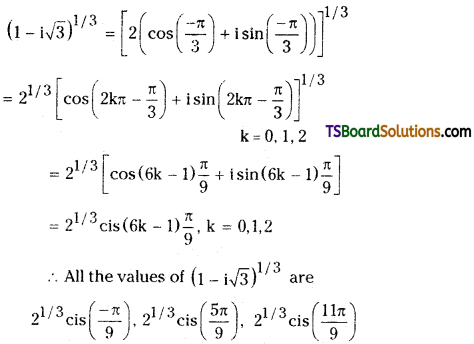

Question 25.
Find the values of (1 + i)2/3.
Solution:
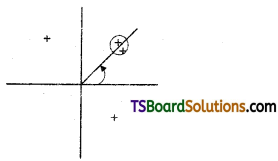
Let. 1 + i = r (cos θ + i sin θ)
then r cos θ = 1, r sin θ = 1
r = \(\sqrt{\mathrm{x}^2+\mathrm{y}^2}=\sqrt{1^2+1^2}=\sqrt{1+1}=\sqrt{2}\)
Hence,
√2 cos θ = 1
cos θ = \(\frac{1}{\sqrt{2}}\)
√2 sin θ = 1
sin θ = \(\frac{1}{\sqrt{2}}\)
∴ θ lies in the Q1.
∴ θ = \(\frac{\pi}{4}\).
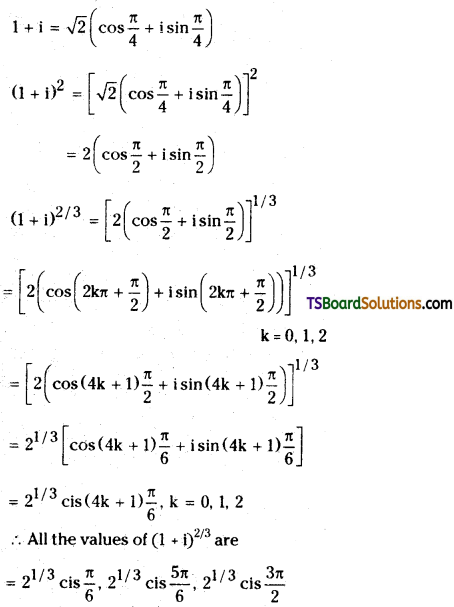
Question 26.
Find all the values of (√3 + 1)1/4.
Solution:
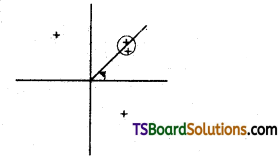
Let, √3 + 1 = r(cos θ + i sin θ)
then r cos θ = r sin θ = 1
∴ r = \(\sqrt{\mathrm{x}^2+\mathrm{y}^2}=\sqrt{(\sqrt{3})^2+1^2}\)
= \(\sqrt{3+1}=\sqrt{4}\) = 2
Hence,
2 cos θ = √3, 2 sin θ = 1
cos θ = \(\frac{\sqrt{3}}{2}\), sin θ = \(\frac{1}{2}\)
∴ θ lies in the Q1.
∴ θ = \(\frac{\pi}{6}\)
∴ √3 + i = 2 (cos \(\frac{\pi}{6}\) + i sin \(\frac{\pi}{6}\))
Now,
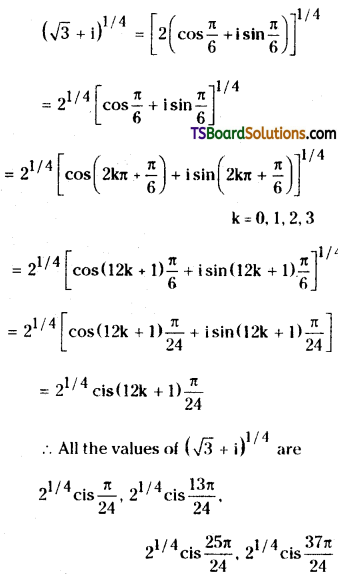

Question 27.
Find all the values of (- i)1/6.
Solution:
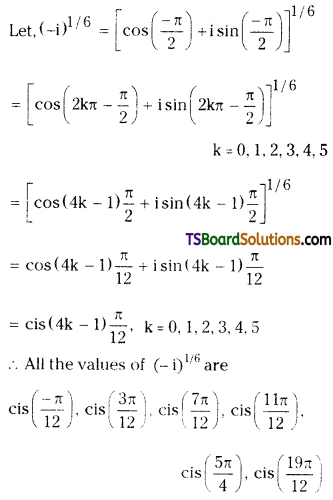
Question 28.
Find all the values of (- 16)1/4.
Solution:
Let, (- 16)1/4 = (16)1/4 . (- 1)1/4
= (24)1/4 (- 1)1/4
= 2 [cos π + i sin π]1/4
= 2 [cos(2kπ + π) + isin(2kπ + π)]1/4, k = 0, 1, 2, 3
= 2 [cos(2k + 1)π + isin(2k + 1)π]1/4
= 2 [cos(2k + 1)\(\frac{\pi}{4}\) + i sin (2k + 1)\(\frac{\pi}{4}\)]
= 2 cis(2k + 1)\(\frac{\pi}{4}\), k = 0, 1, 2, 3
If k = 0
⇒ x = 2 cis \(\frac{\pi}{4}\)
If k = 1
⇒ x = 2 cis \(\frac{3 \pi}{4}\)
If k = 2
⇒ x = 2 cis \(\frac{5 \pi}{4}\)
If k = 3
⇒ x = 2 cis \(\frac{7 \pi}{4}\)
∴ All the values of (- 16)1/4 are 2 cis \(\frac{\pi}{4}\), 2 cis \(\frac{3 \pi}{4}\), 2 cis \(\frac{5 \pi}{4}\), 2 cis \(\frac{7 \pi}{4}\)

Question 29.
Find all the values of (- 32)1/5.
Solution:
Let, x = (- 32)1/5
= (32)1/5 (- 1)1/5
= (25)1/5 [cos π + i sin π]1/5
= 2 [cos π + i sin π]1/5
= 2 [cos (2kπ + π) + i sin (2kπ + π)]1/5
k = 0, 1, 2, 3, 4
= 2 [cos (2k + 1)π + i sin (2k + 1)π]1/5
= 2 [cos (2k + 1)\(\frac{\pi}{5}\), i sin(2k + 1)\(\frac{\pi}{2}\)]
= 2 cis(2k + 1)\(\frac{\pi}{2}\), k = 0,1 , 2, 3, 4
If k = 0
⇒ x = 2 cis \(\frac{\pi}{5}\)
If k = 1
⇒ x = 2 cis \(\frac{3 \pi}{5}\)
If k = 2
⇒ x = 2 cis π
If k = 3
⇒ x = 2 cis \(\frac{7 \pi}{5}\)
If k = 4
⇒ x = 2 cis \(\frac{9 \pi}{5}\)
∴ All the values of (- 32)1/5 are 2 cis \(\frac{\pi}{5}\), 2 cis \(\frac{3 \pi}{5}\), 2 cis π, 2 cis \(\frac{7 \pi}{5}\), 2 cis \(\frac{9 \pi}{5}\).
![]()













